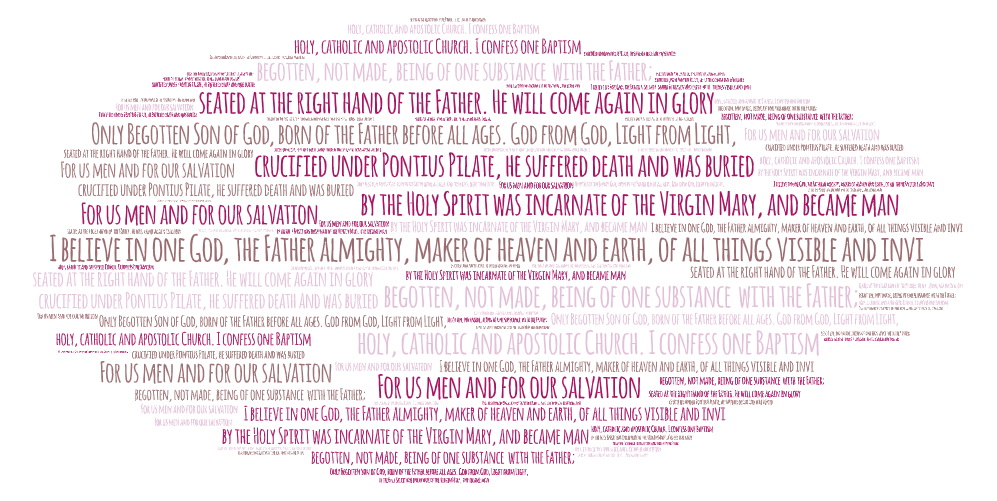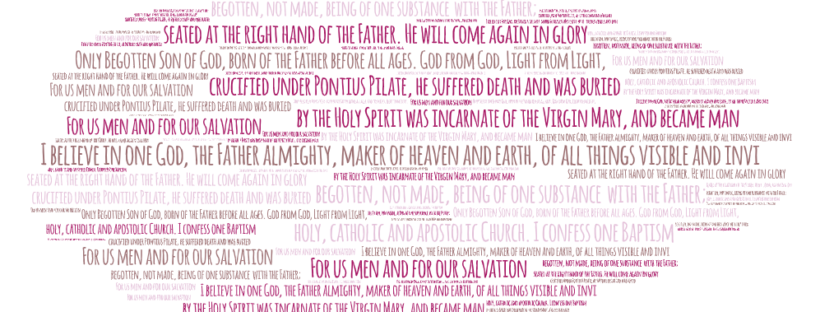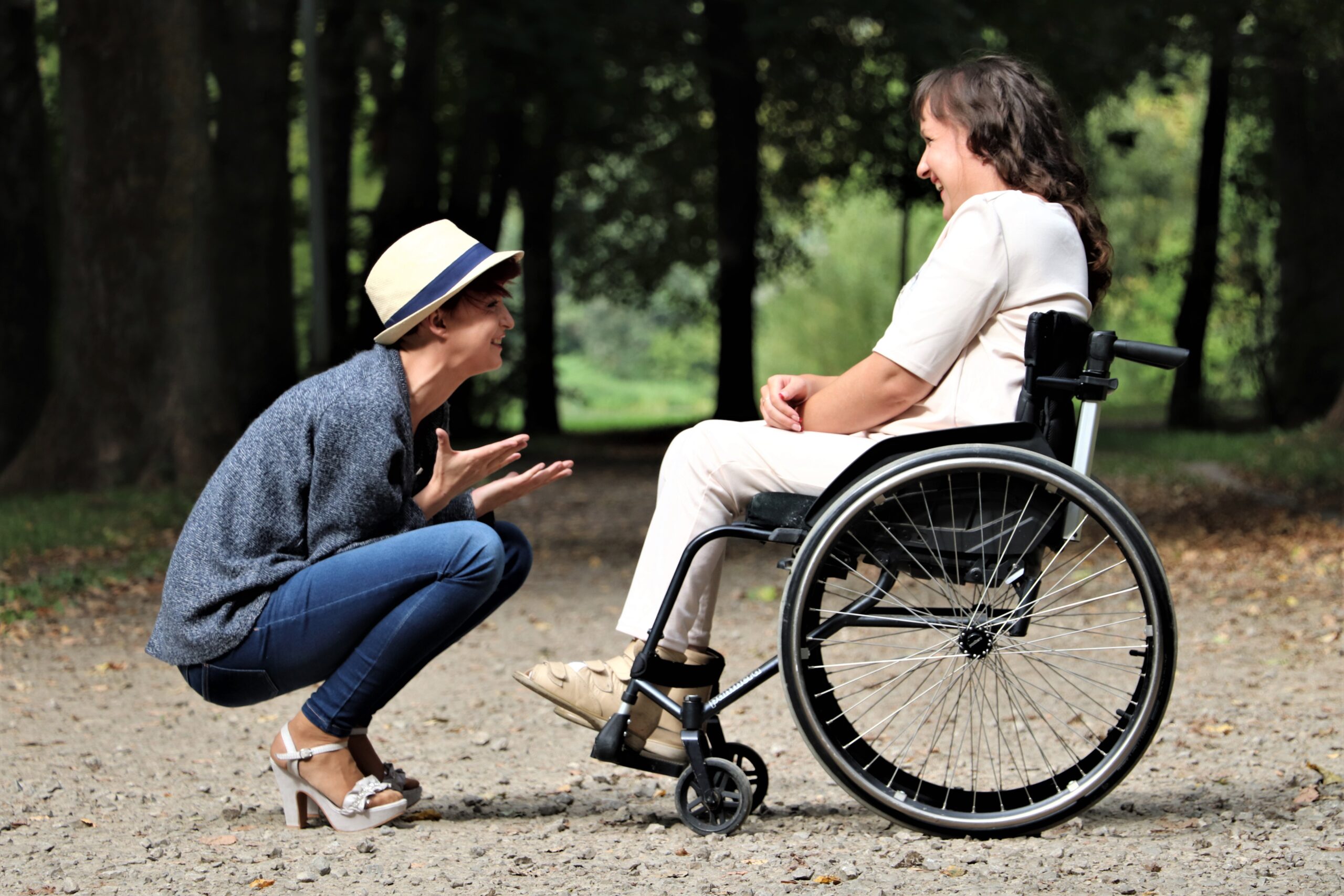In September 2024, a friend of mine who was writing a paper on the Nicene Creed, requested my thoughts on the creed. In this blog post I share an adaptation of the reflection that I shared with my friend on the Creed and what it means to me today. My reflections may seem to cover aspects far removed from the context in which the Creed arose. But in as far as it is an affirmation we, as a reformed and reforming church, still use as a public affirmation in our liturgical practices 1700 years later, I feel it is relevant to critique it in the light of our own faith journeys and experiences as people belonging to various marginalised groups who are still at the fringes of the institutionalised church.
The World Council of Churches in its web page announcing activities to commemorate the 1700th anniversary, says:
In Nicaea, Christians who only recently had been persecuted in the Roman Empire were able to gather under the patronage of the emperor to affirm their faith and witness to the society around them. Then, as now, the call to unity was heard within the context of a troubled, unequal, and divided world.
If, therefore, the Nicene creed, is to be understood as a call to unity within the current context of “a troubled, unequal, and divided world,” then must we not introspect whether it speaks to the experiences and aspirations of the marginalised communities who are part of the body of Christ?

And so I reflect here from the perspective of the many spaces and identities I inhabit: as a woman, an Indian, a feminist theologian, a mother, and as one who is in spaces of advocacy for gender justice, disability rights, child rights, and LGBTQI rights. I critique each of the clauses in the Creed from these multiple identities and roles that have shaped my life and faith.
We believe in one God, the Father, the almighty, maker of heaven and earth, of all that is, seen and unseen.
For me as a woman, a feminist, a mother, and as one who is in advocacy for gender justice, disability rights, and child rights, the terms “Father” and “almighty” are problematic in a global confession meant for all Christians.
The term ‘father’ is not a form of address that certain groups are comfortable using. Survivors of domestic violence and rape, for whom family members, like fathers, are abusers, are traumatised by a father-god image. Personally, I had the best father who loved me with an abiding and empowering love. Despite this, I am not comfortable using the term Father in God language or in any confessional creeds and prayers.
I also find the term “almighty” problematic because from the perspective of a person with disability, it raises questions about why the almighty is unable to “heal” or “cure” people living with multiple disabilities who wish to be cured. Simultaneously I acknowledge that there are enough persons with disabilities who fully believe that being born with multiple disabilities attests to the wholeness of their disabled selves reflecting the image of God and that their disabilities are part of the diversity of all creation (by the creator of “all that is”)! So there is this spectrum of understanding within disability perspectives – ranging from the parents, siblings, and care givers who pray for the healing of their children/siblings because they see them “suffer” and be dependent for every bit of their daily routine on another person; to people with cerebral palsy who are wheelchair users and have limited control of their limbs, who declare and affirm with power and conviction -”I am created in the image of God and I am whole as I am and I don’t need to be prayed over for healing!”
The ‘overlord’ or ‘master’ overtones to this term ‘almighty’ also does not lend itself as enabling for a person who is at the bottom of a caste hierarchy not of their choosing. A dalit would much rather not use a term that reminds one of the ‘almighty’-ness of an upper caste over the lives, labour, and bodies of dalits.
So rather than the term “almighty,” we would better relate to a “vulnerable God” who is still the creator of all things, seen and unseen, and who walks alongside us in all that we experience in our bodies and in our living as those belonging to marginalised spaces that invisiblise and villify our identities.
We believe in one Lord, Jesus Christ, the only Son of God, eternally begotten of the Father, God from God, Light from Light, true God from true God, begotten, not made, of one being with the Father. Through him all things were made.
Over the years as I have evolved, I have come to distrust any tendency that drives towards “one God/ one Lord/ one true God” as limiting, and divisive of the plural fabric which is the reality of our shared inter-faith living in this world.
In as much as we oppose Hindutva, we need to oppose the Christian-Taliban-like tendencies, and uttering these words in our creed/affirmation of faith reinforces our own exclusivist and triumphalistic thinking that is not helpful for plural living in this multi-religious world.
While being grateful that the Church Fathers found it justified to use the phrase “begotten not made,” I find it infinitely problematic, as a feminist, that this is followed by the phrase “of one being with the father” – almost implying a total erasure of the mother who begot Jesus in her form and body as an embodied woman!
I find it much more natural, healing, and joyful to say with some of the creative indigenous religious liturgies that affirm the woman as the mother of all creation, “Through her all things were made.”
“Light of Light”- As one who has been struggling with PTSD and mental health issues like depression, anxiety, and panic attacks over the past few years, I have also found it increasingly difficult to relate to “light” as against darkness, as empowering or affirming. It is in the darkest of dark times that the deepest of epiphanies happen, and the profoundest of theologies arise. God was already hovering in the deep … God did not come into existence after the light (and night) was created, She was brooding over all of the universe even before there was the word and then the light.
I believe it is that ancient primordial spirit that held me in my darkest times when I couldn’t breath, and brooded over me, prevented me from submitting to the so-called “dark” thoughts of ideation, and kept saying, “breath, you are more than this, I will see you through!” Through that brooding spirit hovering over the dark I found my way back. It was she who wrapped me in darkness but promised me that the darkness would not consume me, but would be a fecund place from which I will rise again – bruised and battered, but stronger, and able to handle the harshness of the glaring light again!
For us men and for our salvation he came down from heaven; by the power of the Holy Spirit he became incarnate of the Virgin Mary, and was made man.
For our sake he was crucified under Pontius Pilate; he suffered death and was buried.
I find these words totally alienating from the understanding of sin, suffering, and salvation, that I have come to understand, believe, and live by. Again the “men” language is annoying! But that apart, the need for the Church Fathers to insist on virginity as the only possible route through which God could be incarnated only manifests their deep misogyny and distrust for the female body and the reproductive powers that lie in biologically female bodies, which men had no control over. The repurcussions of this misogyny and need to control a woman’s body is still evidenced in the fact that many churches still use the biological aspects of women (reaffirmed by gendered socialisation) to exclude them from priestly roles and significant leadership roles in faith spaces. The Church’s attempt to control a woman’s right over her own body by villifying contraception and abortions are also a legacy of this deep-rooted need to control women’s bodies and reproductive choices.
The inherent sinfulness of all humanity and this need for an external saviour – is not the soteriological understanding that the Jesus story has come to mean for me. The penal substitution theory of sin and need for a God to be satisfied with the death of his son- is not based on the God of the Bible that I believe in.
The passive language of “was crucified, suffered death, and was buried,” goes against the grain of the historical facts of the active socio-politiocal and religious forces that ‘killed’ Jesus. Jesus was not “crucified for our sake!” Jesus was “murdered” for questioning and challenging the oppressive kyriarchal Empire of his time and the religious authorities of his time. “He was killed.” He did not voluntarily flog himself, place a crown of thorns on his own head, carry a cross (while being forced to do so with whips and) as a form of public humiliation, climb himself on to the cross and nail and spear himself and allow himself to be killed like a criminal! It was political, religious, economic powers of his time that colluded to murder the ordinary man from Nazareth, son of a carpenter, and son of Mary who sang him revolutionary lullabies about the tumbling of those in power and the rich being brought low, who dared to question, and inspired others to question. He was murdered to make him an example! And this was a threat, so that others would not follow his path ever again! So why don’t we turn the language on its head and name it for what it is in our Creed to say, “He was killed by religious and political forces of Empire, and made a public example to silence all dissent to death-dealing forces”?
On the third day he rose again in accordance with the scriptures; he ascended into heaven and is seated at the right hand of the father.
The resurrection understanding that I believe in is, that despite being killed for challenging the oppressive powers of his time, the Jesus movement did not end with his murder. His path of resistance without violence, against all that was death-dealing, lived on. His lessons of forgiveness, and the principle of ‘the first one who was sinless throwing the stone,’ and walking and living in the company of the most marginalised in his times – the women, the lepers, the disabled, the tax-collectors, the so-called “sinful” according to Jewish legalities – lived on in and through all his followers, not just through the apostles. That the Christian faith continued to thrive in the face of persecution in the years soon after Jesus was killed, and that it survives persecution today, is thanks to those who committed to following the path of Jesus (not that of the institutionalised religion that the apostolic hierarchical Church would later become!)
As a feminist, I cannot help but wonder at the omission from this creed of the role of women who defied Roman threats to their lives to visit Jesus’ tomb, and also cultural practices that considered dead bodies polluting (who better than women understood what ‘polluting’ meant as they were considered polluting every month of their biologically reproductive lives and even when they gave birth?); women who were the first to announce that the tomb was empty, and the first resurrection witnesses to formulate that “Jesus Lived! Jesus is Risen” The lack of reference to women resurrection witnesses in this creed is an abiding testament to the absence of women at Nicea 1700 years ago, and a continued indictment of the institutionalised church that to this day actively excludes women around tables that fromulate matters of faith in the form of creeds, and policies of the institutionalised church. It is also evidence that women birth life-giving declarations that sustain movements such as the Jesus movements, and are not interested in dogma that limits.
He will come again in glory to judge the living and the dead, and his kingdom will have no end.
Rather than a legalistic judge, I believe that the kingdom that Jesus kicked off in his lifetime, incarnates again in each time and in each person who fights for justice even at the cost of personal trials and sacrifices, and in every community that bears the scars of unjust systems, yet resists with resilience to name the oppressors and tear down unjust kyriarchal systems.
This ‘kindom’/ kingdom is not a time in the far future, it is here and now, every time a child is born despite the forces of death trying to destroy all of life as we know it on this planet; it is here and now each time a woman with trembling legs and fear in her heart still rises to speak at the tables of powerful men who look on her with derision and veiled disrespect; it is here and now in every little act of kindness we teach children and see them carry through; it is in here and now when each survivor of rape pushes back and resists the shaming and victim-blaming; it is here and now in the story of every dalit who pushes back against the all-pervasive casteism to claw their way through the pain and humiliation to claim fullness of life as a right; it is here and now in every woman street vendor who with resilience and courage faces each day despite the crushing global capitalist empire whose tentacles seek to crush life and the flourishing of life! – And I truly believe such a kindom/kingdom will indeed “have no end,” as long as we continue to resist, to fight, and “surthrive” with resilience!
We believe in the Holy Spirit, the Lord, the giver of life, who proceeds from the Father and the Son. With the Father and the Son he is worshipped and glorified. He has spoken through the Prophets.
I do believe in “God, the creator, provider, and sustainer of life” who continues to accompany and walk with all of god’s creation – human and non-human- to ensure the flourishing of and fullness of life.” The God I believe in, does not depend on our worship and glorification to continue to be God. Because God is in each of us created in God’s image. The Holy Spirit, as wisdom Sophia, is always near and waiting for us to listen to her and invite her to walk with us. It doesn’t matter to me that I go for long periods without singing praise or praying. When I do break forth in praise and worship, it is not addressed to the gendered “Father and Son” but to Jesus my liberator and friend. My god is in me and moves me in everything I do for justice – for self, for neighbour, and in the eyes of my god of justice who indeed spoke through the prophets! I’m inspired by Isaiah, Hosea, and Amos as much as I am by Bathsheba, Rahab, Jael, Deborah, Hagar, Zelophehad’s daughters, Vashthi, Esther, Mary Magdalene and Mary mother of Jesus! The Creed talks of ‘spoken through the Prophets’ as a thing of the past. I believe the canon is not closed and we continue to be inspired by prophets of justice throughout history and in our times. Our God is a living God who continues to speak and move us towards establishing the fullness of life amidst soul crushing kyriarchal forces in this world.
We believe in one holy catholic and apostolic Church. We acknowledge one baptism for the forgiveness of sins. We look for the resurrection of the dead, and the life of the world to come. Amen.
I’m sorry this last bit I have totally no resonance for. I think the “holy catholic and apostolic Church” is just code for a “male patriarchal authoritative (‘power-over’) institution” that has no place for women, for the LGBTQ, for the disabled, the dalits or the poor. I absolutely DO NOT believe in such a church.
And I believe and consistently work towards dismantling such a church.
I believe in the body of Christ that Jesus called all of us to be a part of, regardless!
I believe “I/we are Church,” whenever we become a safe and welcoming space for all, and do the difficult work to dismantle all ‘isms’ – sexism, ableism, casteism, racism – in every area of our lives.
I believe in the Luke 14 feast rather than the Eucharist of the institutionalised church that still discrimates on the basis of gender, disability, and caste.
I believe in the solidarity and camaraderie of the one standing next to me in the protest on the streets of Chennai, rather than the “one baptism” which is a ritual of the institutionalised Church exclusive to those who have paid subscription to that particular Church.
“The resurrection of the dead, and the life of the world to come” is not so much on my radar rather than living a life of kindness, justice, and working to bring peace in the world here and now. Rather than the resurrection of the dead, I believe in the invitation in John 21:1-14 where the resurrected Jesus invites his disciples to join him for a breakfast he had cooked, to have conversations to dismantle fear of the Empire, and to emphasise the importance of food shared as friends in a community where what one eats does not become a license to label or lynch.
And Here I Stand!✊🏾✊🏾✊🏾
So help me Wisdom Sophia to stay true – to self, to God, and my neighbour!!!
- Jessica Richard, Chennai, India, 25 Sep 2024.



